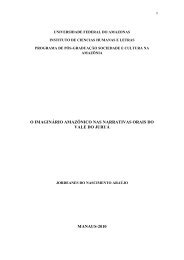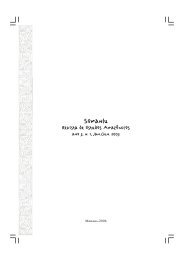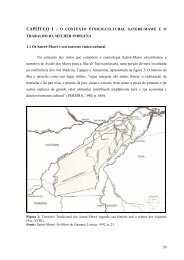somanlu jul dez 2006.pmd - Eventos - Ufam
somanlu jul dez 2006.pmd - Eventos - Ufam
somanlu jul dez 2006.pmd - Eventos - Ufam
You also want an ePaper? Increase the reach of your titles
YUMPU automatically turns print PDFs into web optimized ePapers that Google loves.
“Soldiers” and citizens in the rainforest: Brazilian rubber tappers...<br />
producing tapper was engraved with the image of “the oozing rubber tree whose<br />
precious latex will help to redeem humanity”(ACA, 1943, p. 12).<br />
ACA first announced the rubber tapping contest in June 1943. In one of<br />
the many mobilizational campaigns undertaken on the homefront by President<br />
Getúlio Vargas, June had been designated “National Rubber Month” – at the<br />
urging of United States officials who were eager to boost raw latex production<br />
and the collection of scrap rubber for the war effort. From thousands of bulletins<br />
distributed by ACA to the mayors of the state’s far-flung municipalities came<br />
the announcement of the yearlong rubber contest with the appeal: “Attention,<br />
seringueiros (rubber tappers) of Amazonas: only your work, seringueiro, undertaken<br />
with good will, energy, and decisiveness can ensure rubber for our army and<br />
armies of the other nations that are fighting against Germany and Italy” (ACA,<br />
1944a, p. 91).<br />
These wartime tappers formed part of a broad Brazilian-American<br />
campaign – underwritten by the U.S. government – to supply rubber for the<br />
Allies through the mobilization of local tappers and the mass migration of<br />
Brazilians from the northeastern region (nordestinos) to the labor-scarce Amazonian<br />
rainforest. In a patriotic flourish, the Vargas regime deemed the “tappers soldiers”<br />
(soldados da borracha) engaged in the “battle for rubber.” With financing from the<br />
U.S. Rubber Development Corporation – RDC, the Brazilian government<br />
organized the Serviço Especial de Mobilização dos Trabalhadores para a Amazônia<br />
– SEMTA, which under the terms of an agreement of December 22, 1942,<br />
pledged to transport 50,000 laborers from northeastern Brazil to the Amazon<br />
by the end of May 1943. 2 In a subsequent agreement the RDC agreed to finance<br />
the operations of the Superintendência do Vale Amazônico – SAVA, responsible<br />
for receiving and caring for workers upon their arrival in the Amazon as well as<br />
transporting them to recruitment camps in the rainforest. An extensive public<br />
health program was also undertaken in the Amazon, funded by the Office of<br />
the Coordinator of Inter-American Affairs, to tend to the health of the tappers.<br />
Through its relevant agencies, the Brazilian government assumed full<br />
responsibility for the social welfare and health of the tappers, although the<br />
Rubber Development Corporation was entitled to coordinate and monitor these<br />
efforts. Brazilian and U.S. wartime print media, radio, and film trumpeted state<br />
efforts to uplift the Amazon and its population.<br />
38 Somanlu, ano 6, n. 2, <strong>jul</strong>./<strong>dez</strong>. 2006






